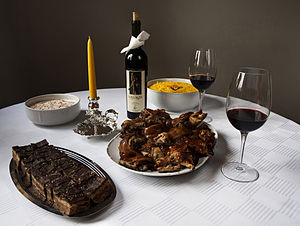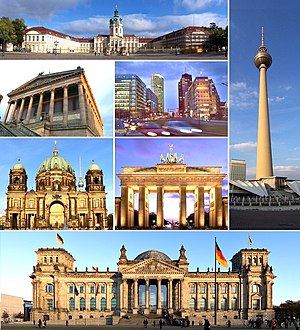Portal:Europe
| Main | Geography | Projects |
|
|
Europe is a continent located entirely in the Northern Hemisphere and mostly in the Eastern Hemisphere. It comprises the westernmost peninsulas of the continental landmass of Eurasia, and is bordered by the Arctic Ocean to the north, the Atlantic Ocean to the west, the Mediterranean Sea to the south, and Asia to the east. Europe is commonly considered to be separated from Asia by the watershed of the Ural Mountains, the Ural River, the Caspian Sea, the Greater Caucasus, the Black Sea, and the waterways of the Turkish Straits. Although much of this border is over land, Europe is generally accorded the status of a full continent because of its great physical size and the weight of history and tradition.
Europe covers about 10,180,000 km2 (3,930,000 sq mi), or 2% of the Earth's surface (6.8% of land area), making it the second smallest continent (using the seven-continent model). Politically, Europe is divided into about fifty sovereign states, of which Russia is the largest and most populous, spanning 39% of the continent and comprising 15% of its population. Europe had a total population of about 741 million (about 11% of the world population), as of 2018. The European climate is largely affected by warm Atlantic currents that temper winters and summers on much of the continent, even at latitudes along which the climate in Asia and North America is severe. Further from the sea, seasonal differences are more noticeable than close to the coast.
The history of Europe concerns itself with the discovery and collection, the study, organization and presentation and the interpretation of past events and affairs of the people of Europe since the beginning of written records. During the Neolithic era and the time of the Indo-European migrations, Europe saw human inflows from east and southeast and subsequent important cultural and material exchange. The period known as classical antiquity began with the emergence of the city-states of ancient Greece. Later, the Roman Empire came to dominate the entire Mediterranean basin. The fall of the Roman Empire in AD 476 traditionally marks the start of the Middle Ages. Beginning in the 14th century a Renaissance of knowledge challenged traditional doctrines in science and theology. Simultaneously, the Protestant Reformation set up Protestant churches primarily in Germany, Scandinavia and England. After 1800, the Industrial Revolution brought prosperity to Britain and Western Europe. The main European powers set up colonies in most of the Americas and Africa, and parts of Asia. In the 20th century, World War I and World War II resulted in massive numbers of deaths. The Cold War dominated European geo-politics from 1947 to 1989. After the fall of the Iron Curtain, the European countries grew together.
The culture of Europe is rooted in the art, architecture, film, different types of music, economic, literature, and philosophy that originated from the continent of Europe. European culture is largely rooted in what is often referred to as its "common cultural heritage".
The economy of Europe comprises more than 744 million people in 50 countries. The formation of the European Union (EU) and in 1999, the introduction of a unified currency, the Euro, brings participating European countries closer through the convenience of a shared currency and has led to a stronger European cash flow. The difference in wealth across Europe can be seen roughly in former Cold War divide, with some countries breaching the divide (Greece, Estonia, Portugal, Slovenia and the Czech Republic). Whilst most European states have a GDP per capita higher than the world's average and are very highly developed (Liechtenstein, Luxembourg, Monaco, Andorra, Norway, Sweden, Denmark, Netherlands, Switzerland, United Kingdom, Ireland, Germany), some European economies, despite their position over the world's average in the Human Development Index, are poorer.
Featured article -
The European Golden Shoe, also known as the European Golden Boot, is an award that is presented each season to the leading goalscorer in league matches from the top division of a European national league. The trophy is a sculpture of a football boot. The award, originally called Soulier d'Or, French for Golden Shoe, was launched in the 1967–68 season, and was given to the top goalscorer in all European leagues during a season. Since 1997, it has been calculated using a weighting in favour of the highest ranked leagues. Originally presented by L'Équipe newspaper, it has been awarded by the European Sports Media since the 1996–97 season. Lionel Messi has won the award most often, six times, all while playing for Barcelona. (Full article...)
Featured location -
Cley Marshes is a 176-hectare (430-acre) nature reserve on the North Sea coast of England just outside the village of Cley next the Sea, Norfolk. A reserve since 1926, it is the oldest of the reserves belonging to the Norfolk Wildlife Trust (NWT), which is itself the oldest county Wildlife Trust in the United Kingdom. Cley Marshes protects an area of reed beds, freshwater marsh, pools and wet meadows and is part of the North Norfolk Coast Site of Special Scientific Interest (SSSI), Special Area of Conservation (SAC), Special Protection Area (SPA), and Ramsar Site due to the large numbers of birds it attracts.
The reserve is important for some scarce breeding species, such as pied avocets on the islands, and western marsh harriers, Eurasian bitterns and bearded reedlings in the reeds, and is also a major migration stopoff and wintering site. There are also several nationally or locally scarce invertebrates and plants specialised for this coastal habitat. It has five bird hides and an environmentally friendly visitor centre and further expansion is planned through the acquisition of neighbouring land and improvements to visitor facilities. (Full article...)
Featured portrait
 |
In the News
- 22 January 2025 –
- Two people are killed, including a two-year-old boy, and two others are injured in a mass stabbing at a park in Aschaffenburg, Bavaria, Germany. The perpetrator is arrested. (Al Arabiya)
- 21 January 2025 –
- One person is killed and another is injured in an explosion at the Port of Barcelona in Barcelona, Spain. (Reuters)
- 20 January 2025 – Russian invasion of Ukraine
- Attacks in Russia during the Russian invasion of Ukraine
- Ukrainian drones attack industrial facilities in Tatarstan, Russia, prompting the Russian Federal Air Transport Agency to temporarily suspend flights at Kazan International Airport in Kazan and Begishevo Airport in Nizhnekamsk. (ABC News)
- 20 January 2025 –
- Eight people are killed and seven others are injured in an arson attack at a nursing home in Barajevo, Belgrade, Serbia. (Reuters)
- 20 January 2025 – Second presidency of Donald Trump
- Anti-Trump protests are held in cities across the United States, as well as in other countries, such as Mexico, Panama, and the United Kingdom. (The Guardian)
Updated: 9:05, 23 January 2025
Categories
Featured biography -
Franz Kafka (3 July 1883 – 3 June 1924) was a Jewish Austrian-Czech novelist and writer from Prague who wrote in German. He is widely regarded as a major figure of 20th-century literature. His work fuses elements of realism and the fantastic, and typically features isolated protagonists facing bizarre or surrealistic predicaments and incomprehensible socio-bureaucratic powers. It has been interpreted as exploring themes of alienation, existential anxiety, guilt, and absurdity. His best known works include the novella The Metamorphosis (1915) and the novels The Trial (1924) and The Castle (1926). The term Kafkaesque has entered English to describe absurd situations like those depicted in his writing.
Kafka was born into a middle-class German- and Yiddish-speaking Czech Jewish family in Prague, the capital of the Kingdom of Bohemia, which belonged to the Austrian part of the Austro-Hungarian Empire (today the capital of the Czech Republic, also known as Czechia). He trained as a lawyer, and after completing his legal education was employed full-time in various legal and insurance jobs. Being employed full-time forced Kafka to relegate writing to his spare time. Few of his works were published during his lifetime; the story collections Contemplation (1912) and A Country Doctor (1919), and individual stories, such as his novella The Metamorphosis, were published in literary magazines, but they received little attention. Over the course of his life, Kafka wrote hundreds of letters to family and close friends, including his father, with whom he had a strained and formal relationship. He became engaged to several women but never married. He died relatively unknown in 1924 of tuberculosis, at the age of 40. (Full article...)
Featured picture
 |
Related portals
Major Religions in Europe
Northern Europe
Western Europe
Central Europe
Eastern Europe, Balkans and Caucasus
Southern Europe
Featured panorama
 |
Topics
Associated Wikimedia
The following Wikimedia Foundation sister projects provide more on this subject:
-
Commons
Free media repository -
Wikibooks
Free textbooks and manuals -
Wikidata
Free knowledge base -
Wikinews
Free-content news -
Wikiquote
Collection of quotations -
Wikisource
Free-content library -
Wikispecies
Directory of species -
Wikiversity
Free learning tools -
Wikivoyage
Free travel guide -
Wiktionary
Dictionary and thesaurus


























